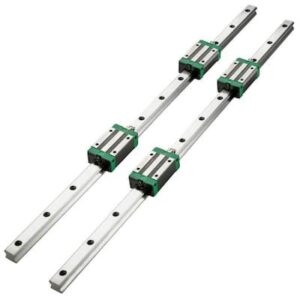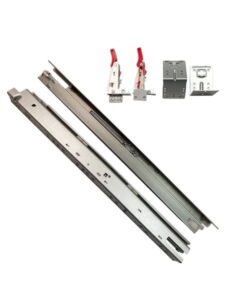Outline for “Linear Track”
| Section | Subtopics |
|---|---|
| Introduction | Overview of precision motion and the role of linear tracks |
| What Is a Linear Track? | Definition, design, and importance |
| How a Linear Track Works | Basic working mechanism |
| Core Components of a Linear Track | Rails, sliders, rolling elements, end caps, seals |
| Types of Linear Tracks | Linear ball tracks, roller tracks, miniature tracks |
| Linear Track vs. Linear Rail | Comparison of structure and applications |
| Material Composition and Coating Options | Steel, stainless steel, and protective coatings |
| Advantages of a Linear Track | Accuracy, rigidity, smoothness, and longevity |
| Applications of Linear Tracks | Robotics, CNC, automation, and optical systems |
| Design and Engineering Considerations | Load, stroke, speed, and alignment factors |
| Installation and Alignment Guide | Mounting techniques for precision |
| Maintenance and Care | Lubrication, inspection, and cleaning |
| YH Linear’s Linear Track Systems | Product line overview |
| YH Linear Manufacturing Quality | Engineering standards and precision control |
| Case Studies and Applications | Success stories from industrial use |
| Why Choose YH Linear Tracks | Advantages over competitors |
| Future Trends in Linear Track Technology | Smart automation and advanced materials |
| FAQs | Six practical questions with detailed answers |
| Conclusion | Recap and brand CTA |
| Suggested Inbound and Outbound Links | SEO strategy links |
Linear Track
In the modern world of precision motion systems, few components are as crucial as the linear track. Whether you’re working with CNC machines, robotic systems, or automation lines, the linear track serves as the foundation of stability, smoothness, and accuracy.
At YH Linear Motion Systems (https://yhlinear.com/), we engineer linear tracks that set new benchmarks for performance, durability, and precision. Our systems are built for industries that demand uncompromising accuracy—from medical devices to semiconductor equipment.
What Is a Linear Track?
A linear track is a mechanical guide system that allows an object to move in a straight line with minimal friction. It consists of a track rail and a carriage block that slides along it using rolling elements like balls or rollers.
The design ensures smooth linear motion, essential for automation, robotics, and CNC applications where consistent and precise positioning is critical.
Unlike conventional slide rails, linear tracks combine compactness with rigidity, offering unmatched stability even at high speeds.
How a Linear Track Works
The linear track operates on the principle of rolling contact. Inside the carriage block are rows of steel balls or rollers that circulate as the block moves. These rolling elements drastically reduce friction compared to traditional sliding systems.
The contact angle between the rolling elements and raceways distributes load evenly, resulting in higher rigidity and longer service life.
This system provides micron-level accuracy, ideal for demanding applications like semiconductor fabrication or robotic assembly.
Core Components of a Linear Track
| Component | Description |
|---|---|
| Track Rail | Precision-ground path that defines linear motion |
| Carriage Block (Slider) | Moves smoothly along the track carrying loads |
| Rolling Elements | Balls or rollers reducing friction |
| End Caps | Return path for rolling elements |
| Seals/Wipers | Prevent dust and debris entry |
| Lubrication System | Maintains consistent performance and reduces wear |
Each element in a YH Linear track is designed with high-grade materials, ensuring reliable motion even in challenging industrial environments.
Types of Linear Tracks
Ball-Type Linear Track:
Uses ball bearings for high-speed, smooth, and quiet motion.Roller-Type Linear Track:
Employs cylindrical rollers for greater rigidity and load-bearing capacity.Miniature Linear Track:
Designed for compact applications such as medical devices, 3D printers, and precision measuring instruments.Stainless Steel Linear Track:
Ideal for cleanrooms, food processing, and medical environments.
Linear Track vs. Linear Rail
| Feature | Linear Track | Linear Rail |
|---|---|---|
| Design | Compact track with carriage | Rail-based guide with block |
| Motion | Linear path with low friction | Linear path with ball recirculation |
| Rigidity | High | Very High |
| Application | Light to medium load systems | Medium to heavy-duty machinery |
| Maintenance | Low | Moderate |
| Use Case | Robotics, optical systems | CNC, industrial automation |
Both systems share similar functionality, but linear tracks are more compact and lightweight, ideal for smaller automated mechanisms.
Material Composition and Coating Options
YH Linear’s tracks are manufactured using premium materials to ensure longevity and precision:
High-Carbon Alloy Steel: Provides maximum hardness and wear resistance.
Stainless Steel (SUS440C): Corrosion-resistant for clean and humid environments.
Chrome and Nickel Plating: Improves durability and reduces friction.
DLC Coating: Offers low friction and high surface smoothness.
These treatments enhance performance in dusty, humid, or corrosive industrial conditions.
Advantages of a Linear Track
Exceptional Precision: Micron-level motion accuracy.
High Rigidity: Handles heavy loads with minimal deflection.
Smooth and Silent Operation: Ideal for noise-sensitive environments.
Corrosion Resistance: Stainless and coated variants available.
Compact Design: Perfect for space-constrained systems.
Easy Installation: Simplified mounting for integration with other components.
Long Life Span: Engineered for consistent performance and durability.
YH Linear’s tracks deliver consistent linearity, even after thousands of hours of operation.
Applications of Linear Tracks
Linear tracks are used across diverse industries, including:
Robotics: Smooth movement of robotic arms and axes.
CNC Machines: Stable, accurate tool guidance.
3D Printers: Ensures consistent layer alignment.
Medical Equipment: Reliable, vibration-free motion in diagnostic devices.
Optical Systems: Smooth tracking for cameras and sensors.
Packaging Machines: Fast, precise conveyor motion control.
Each application benefits from precision alignment, low friction, and durability offered by YH Linear tracks.
Design and Engineering Considerations
When selecting a linear track, engineers should evaluate:
Load Capacity (N): Static and dynamic forces on the system.
Speed Requirements: Operating velocity and acceleration.
Travel Stroke: Maximum required motion range.
Mounting Space: Compactness and alignment accuracy.
Environmental Factors: Exposure to dust, moisture, or chemicals.
YH Linear provides engineering consultations to help select the ideal configuration for your system.
Installation and Alignment Guide
Prepare a Flat Mounting Surface – Ensure no warping or unevenness.
Position the First Track – Align using precision tools.
Secure Bolts Evenly – Apply uniform torque.
Check Smooth Motion – Move the carriage manually to test.
Apply Lubrication – Use manufacturer-recommended grease.
Run Calibration Tests – Verify accuracy before operation.
Proper installation ensures long-lasting precision performance.
Maintenance and Care
Lubrication: Reapply every 400–600 operational hours.
Cleaning: Use lint-free cloths to remove debris.
Inspection: Check for uneven wear or vibration.
Seal Replacement: Replace damaged seals promptly.
Storage: Keep rails flat and dry to avoid deformation.
Routine maintenance extends system life and ensures consistent accuracy.
YH Linear’s Linear Track Systems
YH Linear’s product portfolio includes:
H-Series: Heavy-duty precision tracks for industrial machinery.
M-Series: Miniature tracks for compact and robotic applications.
S-Series: Stainless steel tracks for cleanroom or medical use.
C-Series: Custom tracks designed per client requirements.
Each track is tested for dimensional precision, straightness, and surface finish to meet ISO and JIS standards.
YH Linear Manufacturing Quality
Precision grinding to within ±0.005mm.
100% inspection of all components before shipping.
Automated lubrication testing for long-term performance.
ISO 9001 and CE certification compliance.
On-demand technical support for OEM clients.
YH Linear’s commitment to quality ensures unmatched reliability and precision.
Case Studies and Applications
Robotic Assembly Lines: Improved stability and motion control reduced downtime by 15%.
CNC Router Machines: Enhanced tool path accuracy by 0.002 mm.
Medical Imaging Equipment: Achieved ultra-smooth scanning motion for better imaging clarity.
Each case proves that YH Linear tracks deliver tangible performance benefits across industries.
Why Choose YH Linear Tracks
Unmatched precision with competitive pricing.
Global compatibility with standard rail models.
Custom preload and material options.
Rapid delivery and OEM support.
Proven reliability in international markets.
Visit https://yhlinear.com/ to explore our complete range of linear motion solutions.
Future Trends in Linear Track Technology
The next generation of linear tracks will integrate smart sensors, predictive maintenance systems, and self-lubricating materials.
YH Linear is already investing in IoT-enabled linear motion systems, designed to monitor vibration, load, and lubrication in real-time — ensuring zero downtime and longer operational life.
Frequently Asked Questions
What is a linear track used for?
It guides motion in a straight line with high accuracy and minimal friction.
Are linear tracks the same as linear rails?
They share similar functions but differ in structure — tracks are more compact and lightweight.
Can YH Linear tracks handle heavy loads?
Yes, especially our H-Series, designed for high-load industrial applications.
Do YH Linear tracks require regular lubrication?
Yes, proper lubrication ensures smooth motion and long service life.
Are YH Linear tracks corrosion-resistant?
Yes, stainless steel and coated versions are available for harsh environments.
Can YH Linear make custom-sized tracks?
Absolutely, we offer OEM customization for length, preload, and materials.
Conclusion
A linear track is more than a component—it’s the backbone of modern precision motion. With YH Linear’s expertise, these tracks combine robust engineering, advanced materials, and cutting-edge technology to deliver unmatched reliability and precision.
From small robotic systems to large CNC equipment, YH Linear provides motion solutions that redefine accuracy.
👉 Explore our full range of linear tracks at https://yhlinear.com/ and experience the difference of true precision.
Suggested Inbound and Outbound Links
Inbound Links (YH Linear site):
Outbound Links:



